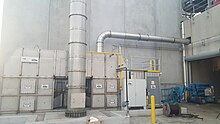Our website is made possible by displaying online advertisements to our visitors.
Please consider supporting us by disabling your ad blocker.
Duct (flow)



Ducts are conduits or passages used in heating, ventilation, and air conditioning (HVAC) to deliver and remove air. The needed airflows include, for example, supply air, return air, and exhaust air.[1] Ducts commonly also deliver ventilation air as part of the supply air. As such, air ducts are one method of ensuring acceptable indoor air quality as well as thermal comfort.
A duct system is also called ductwork. Planning (laying out), sizing, optimizing, detailing, and finding the pressure losses through a duct system is called duct design.[2]
- ^ The Fundamentals volume of the ASHRAE Handbook, ASHRAE, Inc., Atlanta, GA, USA, 2005
- ^ HVAC Systems – Duct Design, 3rd Ed., SMACNA, 1990
Previous Page Next Page


